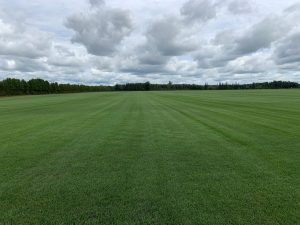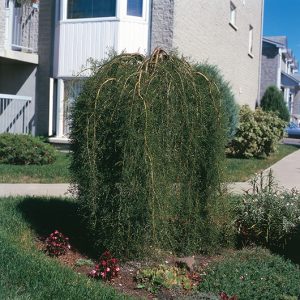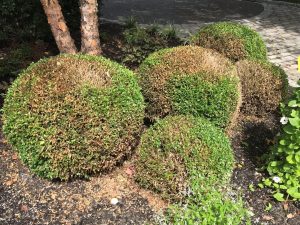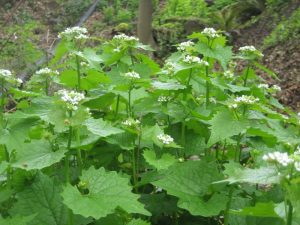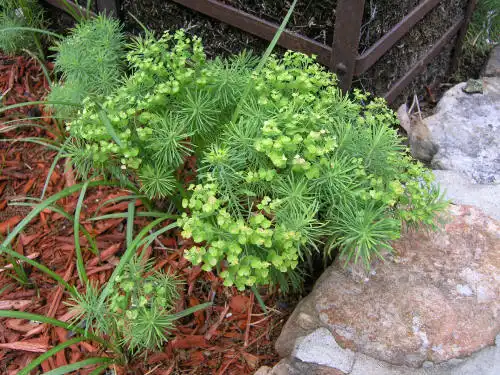
Hi, Dave here from Foxy Gardens in southwestern Ontario. In Ontario’s varied ecosystems, both native and invasive plants vie for space. One group that often flies under the radar is the spurge family—plants within the Euphorbia genus.
While some spurges are quiet contributors to local biodiversity, others are aggressive invaders. And confusing things further, not all plants called “spurge” are true spurges—Japanese Spurge, for example, isn’t in the Euphorbia family at all.
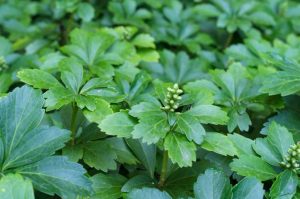
In this article, we’ll explore how to tell native spurges apart from invasive ones in Ontario, discuss their impacts, and offer some guidance on what to grow—or not grow—in your own garden.
What Is a Spurge?
“Spurge” refers to plants in the Euphorbia genus, which includes over 2,000 species worldwide. These plants are known for a few defining traits:
-
Milky, latex-like sap (which can irritate the skin or eyes)
-
Tiny flowers surrounded by colorful bracts (sometimes mistaken for petals)
-
Adaptability—some are hardy ornamentals, while others thrive in poor soil or harsh climates
Spurges appear in many forms: upright perennials, low-growing groundcovers, even cactus-like desert plants. In Ontario, most of our concern lies with a few wild species—some of which belong here, and others that definitely do not.
Native Spurges in Ontario
Ontario is home to several native spurges that quietly support local biodiversity and often go unnoticed.
Euphorbia corollata (Flowering Spurge)

One of the most charming native spurges is Euphorbia corollata, or flowering spurge. This drought-tolerant perennial grows up to 3 feet tall and produces delicate white blooms in mid to late summer. It’s especially beneficial to native bees, butterflies, and other pollinators.
You might spot it in open woodlands or prairie-style landscapes. It’s occasionally planted in native gardens and restoration projects, especially in southern Ontario.
Euphorbia missurica (Prairie Spurge)

Although rarer, Euphorbia missurica is another native species found in sandy or open areas. This small, low-growing plant is adapted to dry environments and may be found in Ontario’s few remaining tallgrass prairie remnants.
These native spurges are well-behaved, non-aggressive, and adapted to coexist with other native plants. They can make unique additions to wildflower gardens where conditions suit them.
Invasive Spurges in Ontario
Unfortunately, not all spurges are so cooperative. A few Eurasian imports have spread aggressively through fields, roadsides, and disturbed lands, crowding out native species and even harming livestock.
Euphorbia esula (Leafy Spurge)
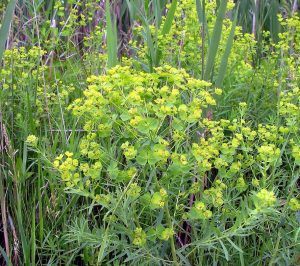
Perhaps the most problematic spurge in Ontario, Euphorbia esula—commonly called leafy spurge—is a vigorous perennial invader.
-
Origin: Eurasia
-
Habit: Grows up to 90 cm (3 feet), with narrow green leaves and clusters of yellow-green bracts
-
Problem: It spreads rapidly through underground rhizomes and seeds
-
Toxicity: Its sap is toxic to livestock and irritating to humans
Leafy spurge is especially troublesome in pastures, roadsides, and nature reserves. Once established, it’s hard to remove. It can regenerate from root fragments and tends to outcompete native plants.
Euphorbia cyparissias (Cypress Spurge)
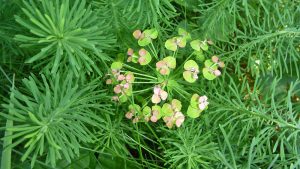
A close relative of leafy spurge, Euphorbia cyparissias is often called cypress spurge. It’s smaller and finer in texture, often growing in colonies with needle-like foliage and bright yellow flowers.
Though often sold historically as an ornamental groundcover, it has since escaped gardens and become invasive in some Ontario regions. Like its larger cousin, it spreads underground and produces toxic sap.
Identification Tips
To tell spurges apart:
| Feature | Native Spurges | Invasive Spurges |
|---|---|---|
| Sap | Milky (mildly irritating) | Milky (can be very irritating/toxic) |
| Growth | Clumping, sparse | Dense colonies via rhizomes |
| Habitat | Prairies, dry open areas | Roadsides, pastures, disturbed land |
| Leaves | Oval or lance-shaped | Narrow (esula), needle-like (cyparissias) |
Always wear gloves when handling spurges, as even native ones can cause skin irritation.
What About Japanese Spurge?
Despite the name, Japanese Spurge (Pachysandra terminalis) isn’t a true spurge at all. It’s a member of the boxwood family (Buxaceae) and is widely used in ornamental landscaping for shady groundcover.
Why It’s a Problem in Ontario
-
It spreads aggressively via rhizomes
-
It forms dense mats that outcompete native forest floor plants
-
Once established, it’s hard to remove
-
It doesn’t support native pollinators or wildlife
While it’s not currently listed as a regulated invasive species in Ontario, many conservation groups discourage its use near naturalized areas, forests, or conservation lands.
Safer Alternatives:
If you’re looking for groundcover, consider native options like:
-
Wild ginger (Asarum canadense)
-
Foamflower (Tiarella cordifolia)
-
Canada anemone (Anemone canadensis)
These species are attractive, less aggressive, and far more beneficial to local ecosystems.
Should You Plant Spurge in Your Garden?
✅ Yes, if it’s a native species like Euphorbia corollata and you have dry, sunny conditions where pollinators will benefit.
🚫 No, if it’s an invasive species like leafy or cypress spurge, or even Japanese spurge if you live near a natural woodland.
Also, be mindful when buying plants or swapping with friends—misidentified spurges sometimes sneak in as “drought-tolerant groundcovers.”
Controlling Invasive Spurges
If you find leafy or cypress spurge on your property, early removal is key. Here’s how:
-
Manual removal: Dig deeply and repeatedly to remove root systems
-
Wear gloves: Avoid sap contact
-
Dispose responsibly: Do not compost invasive plants; bag and discard with yard waste
-
Follow up: Revisit infested areas, as regrowth is common
In large infestations, professional help or targeted herbicide application may be necessary—but only as a last resort and in accordance with local pesticide laws.
Conclusion
Spurges are a mixed bag in Ontario. Some are valuable native wildflowers that support pollinators, while others—especially Eurasian and ornamental varieties—pose serious threats to native ecosystems.
Understanding which spurges are safe and beneficial can help you make better decisions in your garden or natural space. And when in doubt, lean toward native plants that help restore and protect Ontario’s delicate plant communities.

